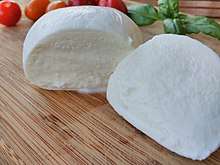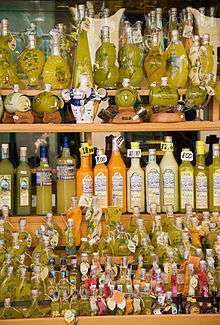Campania
Campania is a region of Southern Italy. With 5.8 million citizens it is Italy's third most populous, and the most densely populated.
The region has a rich heritage from Ancient Greek colonies, the Roman Empire and the Renaissance.
Provinces
Campania is divided into five provinces:
| Metropolitan City of Naples (NA) The incredible region capital, mount Vesuvius, the stunning islands of the Bay, remains of every historic age, excellent cuisine. |
| Avellino (AV) Medieval villages and castles, beautiful mountains, renowned DOC wines, natural olive oil, cheeses and "salumi". |
| Benevento (BN) Numerous Roman archaeological sites of its capital city, many medieval old towns situated on green hills. |
| Caserta (CE) The majestic Royal Palace, relevant Roman remains, lakes and mountains of Matese Regional Park, beach resorts on the Gulf of Gaeta. |
| Salerno (SA) Amalfi coast, ruins of Paestum, Cilento National Park with enchanting coastline and immense forests. |
Cities
- 🌍 Naples — Southern Italy's main city, largest historic centre in Europe with dozens of churches and monuments, delicious cuisine and birthplace of pizza
- 🌍 Avellino — remains of the Roman city of Abellinum and an interesting old city
- 🌍 Benevento — lots of Roman era remains and medieval Lombard age monuments
- 🌍 Caserta — biggest Royal Palace of the world by volume and medieval old town
- 🌍 Pozzuoli — lots of Roman archaeological sites in the wonderful area of the Phlegraean Fields
- 🌍 Salerno — vibrant and dynamic city with impressive cathedral and promenade
Other destinations
- 🌍 Amalfi Coast — stunning stretch of coastline on the Gulf of Salerno, with enchanting towns such as Amalfi, Positano, Praiano, Ravello and others.
- 🌍 Ariano Irpino — upon the panoramic Irpinia hills, endowed with medieval sights, museums, and typical restaurants
- 🌍 Calitri — pictoresque town in the heart of Upper Irpinia, known for its characteristic cuisine
- 🌍 Capri and 🌍 Ischia — the famed islands in the Bay of Naples
- 🌍 Cava de' Tirreni
- Cilento and Vallo di Diano National Park
- 🌍 Maiori
- 🌍 Massa Lubrense
- 🌍 Paestum — majestic Greek temples of 6th century BC and beach resort
- 🌍 Pisciotta
- 🌍 Pompeii and 🌍 Herculaneum (Ercolano) — Roman archaeological sites
- 🌍 Sant'Agnello — beautiful village near Sorrento
- 🌍 Sant'Angelo dei Lombardi — medieval small town surrounded by the green hills of Irpinia
- 🌍 Sorrento — wonderful town overlooking the Bay of Naples, famous for its picturesque shops
- 🌍 Vesuvius — world-famous volcano 1.281 metres (4.203 ft) high
Understand
Get in
Get around
Within Campania the public transport has a unified ticket system called Campania Unico . Tickets are organised in zones which means that with one ticket you can travel within one or more zones. The zones radiate out from the centre of Napoli, and allow you to travel within a zone or between zones, with a maximum time limit for the journey. The idea is that you can purchase a single ticket to travel from a zone outside Napoli to the centre, or vice-versa. Included in this system are generally national trains (also to Paestum), the underground in Naples, the Funicolare in Naples, Sita buses along the Amalfi Coast, the Funicolare on Capri, Bus of Ischia the Circumvesuviana that goes also past Pompeii and Herculaneum but NOT ferries. The advantage is not only that you can get tickets for different kind of vehicles, but you could also buy tickets in advance for areas where it is difficult to find a ticket office such as Paestum, as the tickets start to be valid once you stamped them. You should stamp the tickets each time you change vehicle, but be aware that the tickets are only valid for one train, Metro or Funicolare journey. It is possibly also cheaper to buy a bunch of 'one zone' tickets than each time a new one. But careful: some tickets are locally bound (only in Naples, for example). If in doubt, ask when you buy your tickets.
By train

National train lines go from Naples to Salerno and further east and southwards. The Circumvesuviana is a local private train link serving the area around the Mount Vesuvius from Naples to Sorrento. The service has the appeal of typical metropolitan trains connecting to local suburbs (including the odd graffiti and cut open seat/window). For tourists this train service is particularly interesting because it is the only reasonable public transport link to Pompeii, Herculaneum and Vesuvius. Note: there are several different lines but ONLY THE BLUE LINE goes to Pompeii, Herculaneum and Vesuvius. Pompeii is in Zone 3 of Campania, and an one way ticket to (and from) "Zone 3" is €2.80. On weekdays all day ticket is €8.40 and on weekends all day ticket is €4.50. You can use this ticket to get to Pompeii and to get back to Naples. When going to visit the ruins of Pompeii, get off the train at the Pompei Scavi stop. It's about a 40-minute ride from Naples. The entrance is approximately 50m from the station.
By boat
By bus

Buses run generally pretty efficiently, but can become full and a bit uncomfortable. Tickets are part of the Unico Campania system, which must be bought in advance. Once exception is the AliBus, which travels from the airport to the centre of town, where you can buy the tickets on the bus.
Along the Amalfi coastline, buses are the only option, with the exception of ferries. The roads are narrow and winding, but the drivers are exceptionally skilled, only usually being slowed down by the less experienced tour bus drivers.
By car
The Amalfi-Sorrento-Salerno road is narrow and full of hairpin turns. Cars pass fast and close. Take care.
See

- "Cilento and Vallo di Diano National Park with the Archeological sites of Paestum and Velia, and the Certosa di Padula" — a cultural and natural UNESCO World Heritage site consisting of a national park, two ancient Greek archaeological sites and a monastery.
Do
The sea is one of the biggest lures to visitors of the Campania region.
The Amalfi coast presents a series of mountainside towns that seem to tumble into the sea. Also, not far from Naples are some of the most beautiful islands in the world: Capri, Ischia and Procida.
Visit two ancient villages called Ariano Irpino and Calitri, located in the heart of Apennines - equidistant from Tyrrhenian and Adriatic seas. The area around these medieval towns is sprinkled with castles, aristocratic palaces and delightful locations soaked in history and tradition, ridged with hills and valleys and marked by the ancient trails along which Hannibal and his legions marched when setting off to attack ancient Rome 2,000 years ago. One thousand years later Ariano Irpino was the first Norman county in Southern Italy and there King Roger II summoned the Assizes of Ariano in 1140.
Eat

Perhaps the Campania product most widely known is Mozzarella di Bufala, with DOP awarded by the European Union. Due to vast market demand and the scarce number of water buffalo, it is also however a product at risk of a "bufala" (also Italian for scam). To avoid this, each wrapper carries the symbol of the protection consortium to guarantee its authenticity and geographic origin. The origin of the mozzarella – so called from the verb "mozzare" to cut – probably goes back to the 12th century, while the buffalo was already part of the Campanian landscape in the 7th century. The true characteristic of this fresh cheese with a delicate taste is its consistency, which should be firm, slightly elastic and chewy. When cut, the centre of a true mozzarella di bufala 'weeps': an interior still be slightly serous, protected by a thin skin and it should be smooth, but not viscous. It should be preserved in its liquid for no more than 48 hours, preferably not in the refrigerator but in a cool and airy place. As well as the characteristic round form it is produced in braids, knots, nuts and cherries and there is also a smoked version.
It is not possible to talk about Campania's gastronomy without mentioning pizza, particularly pizza margherita. This palate's delight was born in Naples, and legend has it that it was created in honour of Italian Queen Margaret, though this is not true because the same toppings were used at least decades before Italian unification. From simple baked product it became a fanciful, rich, surprising and always appreciated food.
Drink

Local Campanian beverages include limoncello and crema di limone, both lemon-based. Limoncello has the highest alcohol content, is very strong in flavor, and is a very bright translucent yellow color. Crema di limone, as the name suggests, is cream-based. It is less strong than limoncello and is an opaque off-white. Another beverage highly recommended for travelers to Italy is coffee - ask for caffe, espresso, cappuccino, or caffe latte. Especially for US travellers, the quality of the coffee and the drink preparation is vastly better than at home, and a coffee at a small cafe is the perfect way to wind down while in Italy. Coffee or espresso are also staple after-dinner drinks in Italy, but Italians drink cappuccino mainly as a morning drink, so you may get strange looks when ordering this after a meal. Local Italian beer includes Nastro Azzurro, Moretti, and Peroni - all mild-tasting lagers similar to Heineken. Beer is extremely locally available in the cafes and ristorantes in Campania, though wine is more the local drink of choice with a meal. True to Italy's image, wine is readily available in Campania (though at some stores it is less cheap than some travelers may be expecting). Prices in local groceries for a bottle of wine vary somewhere between EURO 4.50-100+. Some of the cities in Campania such as Positano, Sorrento, and cities on the islands of Capri and Ischia will be more expensive due to their high levels of tourism. One local wine of Campania is Lacryma Christi, or "Tears of Christ". This wine is produced on the lower slopes of Mount Vesuvius and is available at many groceries in Campania. For travelers going to the Mount Vesuvius National Park, this wine is available from some of the giftshops at the top at a deeply reduced rate compared with other stores in the area. Terraced land for grape cultivation is frequently visible in countryside of Campania, and many other local wines exist.
Stay safe
Go next
Campania is a good base for exploring other regions of southern Italy such as Basilicata, Calabria and Apulia, as well as Sicily. Lazio and the capital, Rome, are also easily accessible to the north.